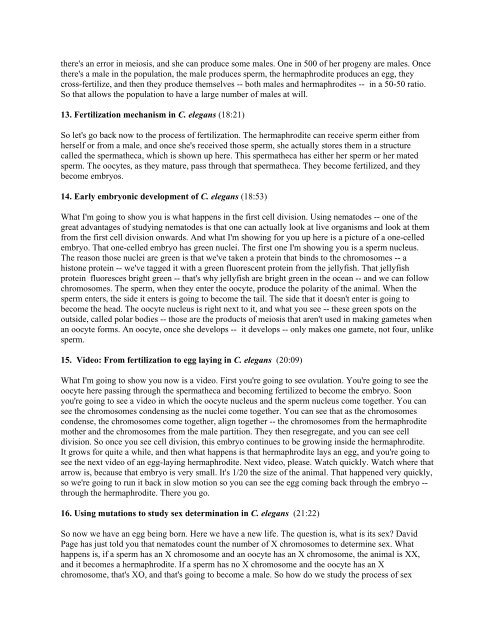The Meaning Of Sex: Genes And Gender Lecture - Howard Hughes ...
The Meaning Of Sex: Genes And Gender Lecture - Howard Hughes ...
The Meaning Of Sex: Genes And Gender Lecture - Howard Hughes ...
Create successful ePaper yourself
Turn your PDF publications into a flip-book with our unique Google optimized e-Paper software.
there's an error in meiosis, and she can produce some males. One in 500 of her progeny are males. Once<br />
there's a male in the population, the male produces sperm, the hermaphrodite produces an egg, they<br />
cross-fertilize, and then they produce themselves -- both males and hermaphrodites -- in a 50-50 ratio.<br />
So that allows the population to have a large number of males at will.<br />
13. Fertilization mechanism in C. elegans (18:21)<br />
So let's go back now to the process of fertilization. <strong>The</strong> hermaphrodite can receive sperm either from<br />
herself or from a male, and once she's received those sperm, she actually stores them in a structure<br />
called the spermatheca, which is shown up here. This spermatheca has either her sperm or her mated<br />
sperm. <strong>The</strong> oocytes, as they mature, pass through that spermatheca. <strong>The</strong>y become fertilized, and they<br />
become embryos.<br />
14. Early embryonic development of C. elegans (18:53)<br />
What I'm going to show you is what happens in the first cell division. Using nematodes -- one of the<br />
great advantages of studying nematodes is that one can actually look at live organisms and look at them<br />
from the first cell division onwards. <strong>And</strong> what I'm showing for you up here is a picture of a one-celled<br />
embryo. That one-celled embryo has green nuclei. <strong>The</strong> first one I'm showing you is a sperm nucleus.<br />
<strong>The</strong> reason those nuclei are green is that we've taken a protein that binds to the chromosomes -- a<br />
histone protein -- we've tagged it with a green fluorescent protein from the jellyfish. That jellyfish<br />
protein fluoresces bright green -- that's why jellyfish are bright green in the ocean -- and we can follow<br />
chromosomes. <strong>The</strong> sperm, when they enter the oocyte, produce the polarity of the animal. When the<br />
sperm enters, the side it enters is going to become the tail. <strong>The</strong> side that it doesn't enter is going to<br />
become the head. <strong>The</strong> oocyte nucleus is right next to it, and what you see -- these green spots on the<br />
outside, called polar bodies -- those are the products of meiosis that aren't used in making gametes when<br />
an oocyte forms. An oocyte, once she develops -- it develops -- only makes one gamete, not four, unlike<br />
sperm.<br />
15. Video: From fertilization to egg laying in C. elegans (20:09)<br />
What I'm going to show you now is a video. First you're going to see ovulation. You're going to see the<br />
oocyte here passing through the spermatheca and becoming fertilized to become the embryo. Soon<br />
you're going to see a video in which the oocyte nucleus and the sperm nucleus come together. You can<br />
see the chromosomes condensing as the nuclei come together. You can see that as the chromosomes<br />
condense, the chromosomes come together, align together -- the chromosomes from the hermaphrodite<br />
mother and the chromosomes from the male partition. <strong>The</strong>y then resegregate, and you can see cell<br />
division. So once you see cell division, this embryo continues to be growing inside the hermaphrodite.<br />
It grows for quite a while, and then what happens is that hermaphrodite lays an egg, and you're going to<br />
see the next video of an egg-laying hermaphrodite. Next video, please. Watch quickly. Watch where that<br />
arrow is, because that embryo is very small. It's 1/20 the size of the animal. That happened very quickly,<br />
so we're going to run it back in slow motion so you can see the egg coming back through the embryo --<br />
through the hermaphrodite. <strong>The</strong>re you go.<br />
16. Using mutations to study sex determination in C. elegans (21:22)<br />
So now we have an egg being born. Here we have a new life. <strong>The</strong> question is, what is its sex? David<br />
Page has just told you that nematodes count the number of X chromosomes to determine sex. What<br />
happens is, if a sperm has an X chromosome and an oocyte has an X chromosome, the animal is XX,<br />
and it becomes a hermaphrodite. If a sperm has no X chromosome and the oocyte has an X<br />
chromosome, that's XO, and that's going to become a male. So how do we study the process of sex

















